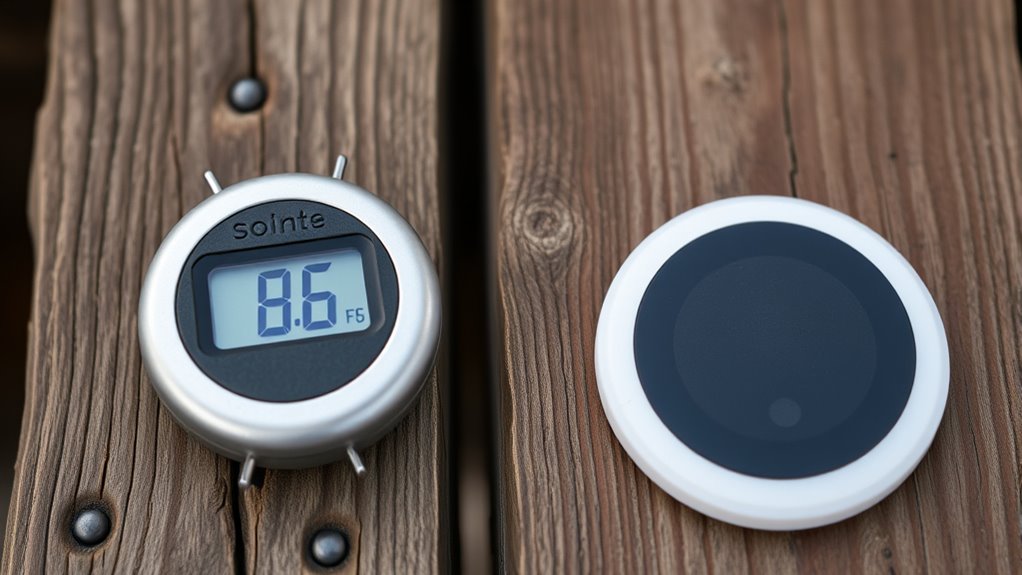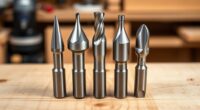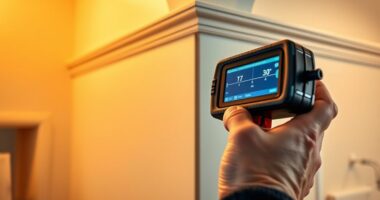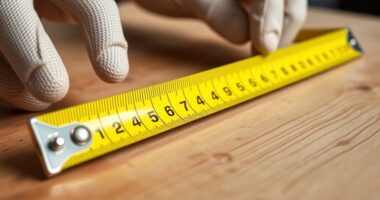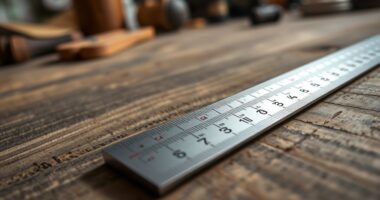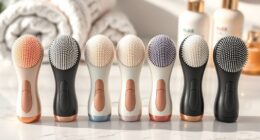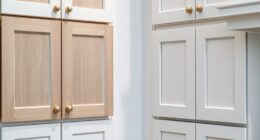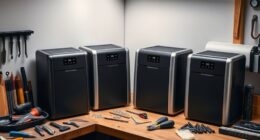When choosing a moisture meter, consider your project needs and material type. Pin meters offer precise, point-specific readings suitable for dense materials, but they can cause surface damage. Pinless meters scan surfaces non-invasively, ideal for finished surfaces and larger areas, though they might be less accurate on dense materials. To guarantee you pick the right tool and use it effectively, there’s more to discover to help you make informed decisions.
Key Takeaways
- Choose pin meters for dense, thick materials needing precise, spot-specific moisture readings.
- Opt for pinless meters to quickly scan large, finished surfaces without causing damage.
- Use pin meters in uneven or irregular materials where surface scans may be less accurate.
- Consider calibration and maintenance needs to ensure reliable results for both device types.
- Match your moisture meter choice to your project’s surface type, material density, and measurement accuracy requirements.
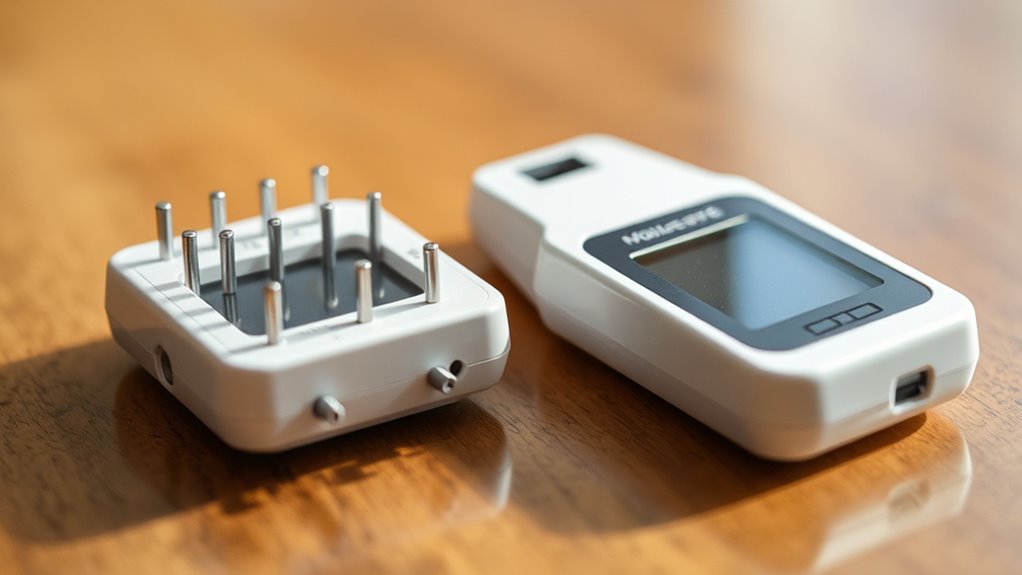
Selecting the right moisture meter is essential for ensuring accurate readings and effective moisture management. When it comes to humidity measurement, choosing between pin and pinless moisture meters can markedly impact the quality of your results. Each type has its advantages and limitations, so understanding their differences helps you pick the best tool for your specific needs. A key aspect to consider is how well the device maintains accurate readings over time, which hinges on proper device calibration. Without regular calibration, even the most advanced moisture meter can give unreliable data, leading to misguided decisions or potential damage.
Choosing the right moisture meter and maintaining calibration ensures accurate, reliable humidity readings for effective moisture management.
Pin moisture meters work by inserting metal pins into the material to measure electrical resistance. This method is often considered more precise for certain applications, especially when you need to measure moisture content in dense or thick materials like hardwood, drywall, or concrete. Because they require direct contact, pin meters can provide detailed moisture readings at specific points. However, they can also cause superficial damage and may not be suitable for delicate surfaces. Proper device calibration is crucial here to ensure that readings are consistent and accurate, especially if you’re using the meter repeatedly across multiple projects or materials. Regular calibration against known moisture standards guarantees your measurements stay reliable, reducing errors caused by sensor drift or environmental factors.
On the other hand, pinless moisture meters use electromagnetic sensors to scan the material’s surface without damaging it. This makes them ideal for measuring moisture in finished surfaces like flooring or furniture where preserving the appearance is important. Pinless models tend to provide a broader view of moisture levels over a larger area, making them useful for detecting hidden pockets of moisture or assessing overall dryness. Since they don’t require insertion, they are faster and less invasive, but their readings can sometimes be less precise in dense or irregular materials. To guarantee their accuracy, regular device calibration is just as essential. Proper calibration aligns the sensor’s readings with known standards, helping you avoid false positives or negatives that could lead to improper moisture management. Additionally, understanding humidity measurement principles enhances your ability to interpret the data accurately.
Whether you choose pin or pinless, understanding humidity measurement and maintaining your device through regular calibration is crucial. This ensures you get consistent, accurate data essential for making informed decisions. Remember, the right moisture meter not only depends on the type of material you’re testing but also on how well you maintain and calibrate the device. Proper calibration routines, paired with a clear understanding of each meter’s strengths and limitations, empower you to manage moisture effectively, prevent damage, and extend the lifespan of your materials and projects.
Frequently Asked Questions
Can Moisture Meters Measure Moisture in Liquids?
Moisture meters aren’t designed to measure liquid moisture directly. They’re mainly used for solid materials like wood, drywall, or concrete. If you need to measure moisture in liquids, you should use a specialized device like a hygrometer or a moisture analyzer. These tools provide accurate measurement of liquid moisture content, ensuring you get reliable results and maintain measurement accuracy for your specific needs.
Are Pinless Meters Affected by Surface Contaminants?
Pinless moisture meters can be affected by surface contamination, which interferes with their readings. Surface contaminants like dirt or coatings can distort calibration accuracy, leading you to get inaccurate moisture levels. To guarantee precise results, you should clean and prepare surfaces before measurement. Regular calibration checks also help maintain accuracy. Being aware of surface contamination’s impact allows you to choose the right techniques for reliable moisture readings.
How Durable Are Moisture Meters in Harsh Environments?
In harsh environments, your moisture meter’s sensor durability is key to lasting performance. You should regularly check calibration frequency to guarantee accurate readings despite exposure to dust, moisture, or extreme temperatures. Proper maintenance, like cleaning sensors and protecting the device, helps extend its lifespan. By choosing a durable model and staying on top of calibration, you can rely on your moisture meter even in tough conditions.
Do Different Materials Require Specific Moisture Meter Settings?
Think of your moisture meter as a finely tuned instrument, sensitive like a whisper. Different materials, like wood or drywall, have unique personalities, requiring you to adjust the settings for true readings. Material sensitivity influences these adjustments, ensuring accurate detection. Regular calibration frequency keeps your meter in harmony with its environment. By tailoring your approach, you reveal precise moisture insights, safeguarding your projects and fostering trust in every measurement.
What Is the Typical Lifespan of a Moisture Meter?
You might wonder about your moisture meter’s lifespan. Typically, it lasts several years with proper maintenance. Regular calibration guarantees accuracy, so check calibration frequency often. Battery life also impacts lifespan; replace batteries as needed to keep it functioning well. Avoid rough handling and store it properly to extend its life. With these habits, your moisture meter can serve you reliably for many years.
Conclusion
Ultimately, selecting the right moisture meter depends on your specific needs and the materials you’ll be testing. Pin meters offer precision for detailed readings, while pinless models provide quick, non-invasive checks. So, consider what’s most important for your projects—accuracy or convenience. Are you willing to trade a little precision for speed? By understanding your priorities, you’ll confidently choose the best tool to guarantee your materials stay in top condition.
